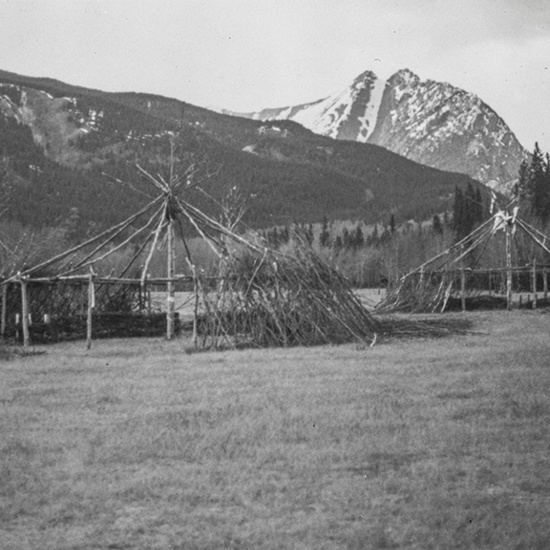Sundance or Thirst Lodge
To battle and deter sickness, ceremonialists would participate in a Thirst or Sundance. This event has foundations in sacrifice and is held in a traditional lodge with its execution varying from Nation to Nation.
To battle and deter sickness, ceremonialists would participate in a Thirst or Sundance. This event has foundations in sacrifice and is held in a traditional lodge with its execution varying from Nation to Nation.
Recent discoveries have pointed to these ceremonial lodges being erected in the Terwillegar area as well as the former reserve lands of the Enoch Cree Nation. During the early days of Edmonton, ceremonies were documented as ongoing, and many Indigenous leaders and peoples gathered in times of healing.
Depending on time of year and which part of the province you were in, prior to colonization, it would have been common for one to see Sundance or Thirst Dance lodges at sacred sites. Using an advanced understanding of architecture, arithmetic and geometry, First Nations would construct these semi-permanent aspen structures to hold complex ceremonies. Using materials gathered from the area, and sometimes brought in for offering, these lodges would be used for the ceremony intended, then left to return to the earth on their own accord. Intertwined with the architecture would be symbolism and teachings to the natural world, deities and other spiritual aspects of First Nations beliefs.
Depending on the Nation, the lodge could be called a Sundance or Thirst Dance lodge, with differences existing between the types of ceremony held therein. Due to cultural teachings and respect, further elaboration of these events should be sought out with knowledge keepers and teachers from First Nations Communities. In Edmonton, certain newspapers had written about Thirst Dances taking place in the River Valley in the late 1800s.
Details
Type
Indigenous
Designation Status
No Historic Recognition
Address
River Valley area,Edmonton, AB
Neighbourhood
Time Period
Pre-Contact and Fur Trade: 11,000 BCE to 1870
Urban Settlement: 1870-1904
Urban Growth: 1905-1913
The War Years: 1914-1945
The Post War Years: 1946-1970
Year Built
n/a
Architects
Architectural Styles
Character Defining Elements
Wood frame , Ceremonial space , Centre pole , Natural materials , Semi-permanent , Aspen cladding
